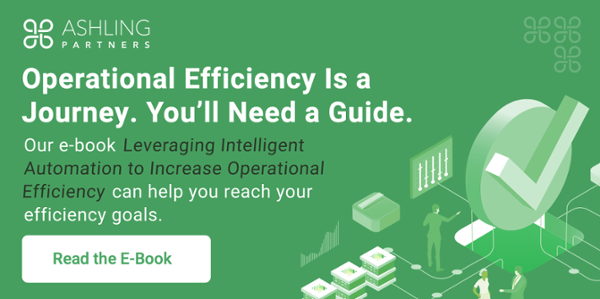Achieving organizational operational efficiency involves multiple strategies. It’s a bit more complex than just reducing costs or improving productivity, but it is still attainable. Many companies attempt to do this with cost-cutting measures, yet they often don’t deliver. In fact, less than 30 percent of these programs achieve their expected results.
What is the best approach for operational efficiency that truly makes a difference? Automation is key, and robotic process automation (RPA) is the first step.
What Is RPA?
RPA is a system in which “software robots” assume repetitive, rules-based tasks. Organizations can scale this form of automation across their enterprise. They can build, deploy, and manage these tools to emulate human actions like keystrokes, navigation, data identification and extraction, and other simple activities.
RPA applies to any industry. Here are some prominent examples:
- The insurance industry uses RPA for many tasks, such as claims registration and processing, adjudications, underwriting, regulatory compliance support, and more.
- Healthcare organizations apply RPA for patient scheduling, claim management, regulatory compliance and audit processes, data sharing, and more.
- E-commerce businesses leverage RPA for customer order processing, support and service via chatbots, and inventory management.
RPA makes each of these processes faster and more accurate. As a result, it fits perfectly with the pursuit of operational efficiency. Let’s dig into some specifics about RPA’s role in these initiatives.
How Does RPA Drive Organizational Operational Efficiency?
The challenges you’re facing around efficiency involve every aspect of your business. From accounting to marketing to operations, there are opportunities to automate. RPA isn’t a magic wand, but it’s a proven strategy that improves operational efficiency.
One key way RPA improves operational efficiency is that it automates repeatable work. If a process is the same each time, you don’t need your human employees to waste their valuable labor on such mundanity. Let software robots take care of these rules-based tasks.
Programming the robots is what takes an inefficient process and transforms it into one that runs on its own. The robots can mimic keystrokes, copy/paste, read and validate data, and perform other simple tasks.
Thanks to these now-automated processes, workflows are faster. Employees who need information or insights from these processes can be more productive as they shift from data entry to work that requires critical thinking.
Here are some case studies that demonstrate RPA’s key role in operational efficiency.
RPA Improves Healthcare Claims Processing
The healthcare claims process is onerous, involving lots of data from different systems and in various formats. One organization found that the manual work required in this process was leading to inaccuracies. After leveraging RPA to automate different stages of the claims process, the organization recovered $2.47 million annually and had a 66 percent increase in hours saved.
RPA Automates Lender Statements
A commercial real estate (CRE) firm used a manual process for monthly lender statements. Workers had to download monthly loan statements and loan history reports, which was time-consuming and repetitive. RPA bots automated the searching and downloading of these documents. As a result, the firm saved 10 hours per month for the employee and reduced manual touches by 2,900.
RPA is the first layer of automation. As you begin with this type of automation, you’ll be able to do even more to realize efficiencies, including process mining.
Process Mining and Operational Efficiency
Process mining creates visualizations of a process based on transactional data. It fills in the gaps between what you think the steps are and what they really are, as confirmed by the data from log files.
With this knowledge, you have a complete picture of a process and can identify where the roadblocks are and how automation could improve these areas. It’s an essential aspect of designing and deploying effective RPA.
Next in the automation journey is document understanding, which relies on RPA and artificial intelligence (AI).
Document Understanding and Operational Efficiency
Document understanding is the act of software robots intaking, processing, and extracting information from unstructured files (e.g., PDFs and images). The robot can open a file, identify its type, and obtain the data fields needed.
Document understanding is another technique in the automation toolbox that drives operational efficiency. You can streamline workflows, eliminate errors that would occur during manual extraction, use data more effectively, and more. Document understanding is also highly scalable.
Finally, you can reach the apex of automation with intelligent automation, which combines RPA, AI, machine learning, and other technologies.
Beyond RPA: Intelligent Automation and Operational Efficiency
Intelligent automation marries RPA and AI technologies, including machine learning and optical character recognition (OCR). With intelligent automation, you can move beyond rules-based tasks and reach the next level of automation with decision-making capabilities.
Applying intelligent automation requires a more thoughtful and calculated implementation. It’s about end-to-end process automation that creates value. Analysis of big data is a common use case, which could help a logistics company optimize routes. Another way this high-level automation makes a business more efficient is by moving data from silos into single interfaces, making it easier to access and reducing a user’s need to go back and forth between systems.
From the building block of RPA to process mining to document understanding to intelligent automation, operational efficiency is an achievable objective.
RPA Plays Critical Role in Operational Efficiency
Mastering RPA is the start of levering automation to facilitate operational efficiency. As you add layers, you can do more, realizing reduced costs, speeding up processes, eliminating errors, and managing data and documents.
Find out more about automation and operational efficiency by reading Leveraging Intelligent Automation to Increase Operational Efficiency.



